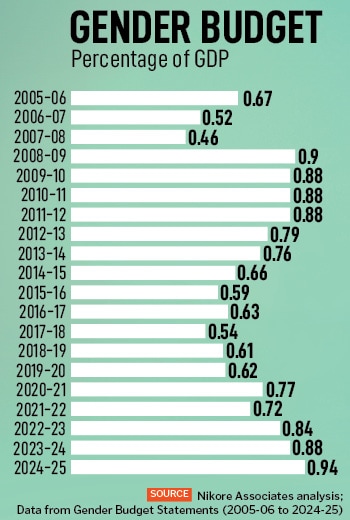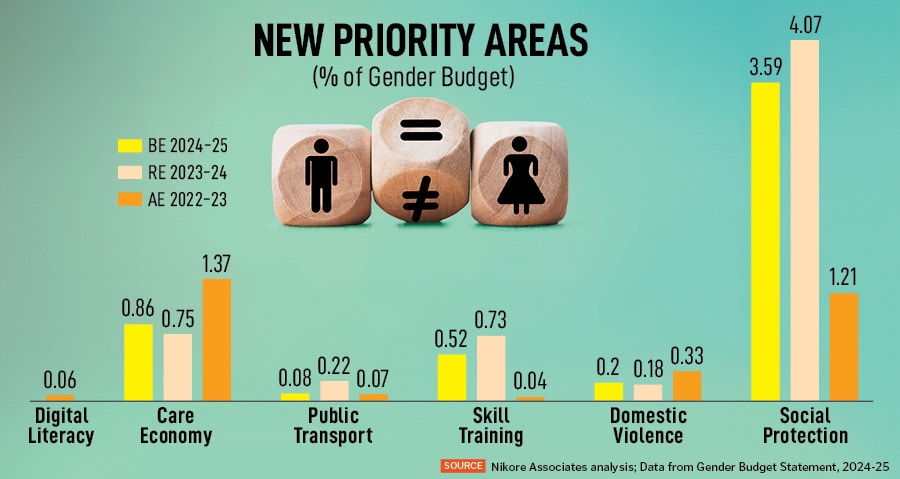Gender mainstreaming, and ensuring that women receive their due benefits under flagship government schemes such as the Jan Dhan–Aadhaar–Mobile (JAM) trinity, the PM Awas Yojana (PMAY), and the Mudra scheme have been key drivers for this measurable progress.
Since 2005-06, each year, the Union Budget has been accompanied by a Gender Budget Statement, which provides a detailed estimate of the share of allocations under each major Ministry and scheme for women and girls. From its modest beginnings with 14 ministries, the interim Gender Budget Statement in 2024-25 included allocations from 38 ministries.
First, the overall allocation of the gender Budget showed a 40 percent increase over 2023-24 budget estimates.
Analysis of data over the last two decades, between 2005-06 to 2024-25 shows that the gender budget has typically hovered between four percent and five percent of the total expenditure, and remained below one percent of the gross domestic product (GDP). Yet, in 2024-25, the interim gender budget increased to 6.5 percent of the total expenditure, and touched nearly one percent of the GDP, breaking its own glass ceiling.
Overall, the gender budget stood at Rs3 lakh crore. At a 40 percent increase over budget estimates of 2023-24, it is the highest annual increase over the last decade. This increase was largely driven by three schemes: The Mahatma Gandhi National Rural Employment Guarantee Scheme (MGNREGS), the PM Ujjwala Yojana, and the Jal Jeevan Mission.
![]() Figure 1: Gender Budget (Percentage of Total Expenditure)
Figure 1: Gender Budget (Percentage of Total Expenditure)
![]() Figure 2: Gender Budget (Percentage of GDP)
Figure 2: Gender Budget (Percentage of GDP)
Second, nearly half the gender budget focusses on women’s financial independence right from education and skill training to livelihoods and entrepreneurship, as well as asset ownership.
Nearly 26 percent of the overall gender Budget is contributed by the PMAY scheme in both rural and urban areas, which focusses on providing property ownership to women, thereby improving their financial independence and granting them the security of having a roof over their head in all emergency situations.
Schemes for livelihood and entrepreneurship, including the MGNREGS, the National Rural Livelihood Mission, and schemes to enhance women’s entrepreneurship in the MSME sector together constitute about 15 percent of the gender Budget.
Education and skill training schemes, such as Samagra Shiksha to improve educational access, and learning outcomes, the Skill India Mission for short term skilling, and the newly launched scheme, Namo Drone Didi, which aims to train women SHG members to operate drone services particularly for irrigation and crop management, constitute another 14 percent of the gender Budget.
These schemes together contribute towards creating an enabling environment to improve women’s labour force participation and entrepreneurship.
Third, there is an increasing focus on gender mainstreaming in green energy sector.
The gender budget for the rooftop solar scheme, which aims to install rooftop solar panels in over one crore households across the country stands at about Rs4,500 crores, nearly half of the total allocation for this scheme overall, indicating that women-owned houses would be a key focus for the scheme.
Moreover, under the PM Kusum scheme that aims to provide solar power agricultural pumps to encourage use of solar energy for farming, nearly Rs2,000 crore is allocated for the gender Budget, signalling that women farmers will remain a key focus group for this scheme.
Yet, there continues to be a need for greater innovation in the gender budget.
Following the trends observed in the last two decades, India’s gender Budget has been concentrated among five key ministries and departments. Even in 2024-25, the top five ministries, namely rural development, drinking water and sanitation, housing and urban affairs, health and family welfare, and education, constituted about 80 percent of the total gender budget.
With time, several new gender gap areas have emerged post-Covid-19 requiring immediate priority, including social protection, prevention of domestic violence, skill training, safe and inclusive public transport, digital literacy, and support for unpaid care and domestic work. Analysis shows that the the total allocation for schemes in these areas comprised just about five percent of the gender budget, with critical areas such as digital literacy, and safe cities seeing budget cuts in 2024-25.
![]() Figure 3: Decomposition of the gender budget, ministry-wise (%)
Figure 3: Decomposition of the gender budget, ministry-wise (%)
![]() New Priority Areas
New Priority Areas
For truly enabling women’s leadership as agents of socio-economic development, it is essential to monitor the implementation of gender Budgets closely, and measure the gender disaggregated impact of each rupee invested in gender Budgets. In the short to medium term, governments may consider undertaking gender audits of Centrally sponsored schemes (CSSs) and flagship programs.
In addition, the gender budget statement should include measurable outcome and output indicators, and their annual progress should be reported. Most importantly, collection of gender-disaggregated data should be mainstreamed as a basic minimum requirement across dashboards of all CSSs, so as to normalise this practice.
Finally, capacity of gender Budget cells, which exist across 57 central ministries and 16 state governments should be enhanced through regular training. Central ministries and states that are yet to adopt gender-responsive budgeting (GRB) should be supported through additional capacity building measures.
India has chosen to take a path of women-led development, differentiating itself from other emerging economies and G20 countries which focus on women’s development. Strong, dynamic, transparent and innovative gender budgets are a key tool for unlocking Nari Shakti.
Mitali Nikore is the founder of Nikore Associates, a youth-led economics research and policy think-tank
(Research assistance: Suhruda Dasyam, Abhiniti Gupta & Divyaanshu Sahrawat)




